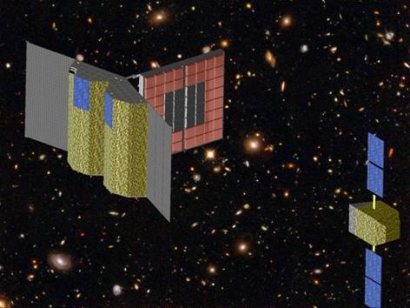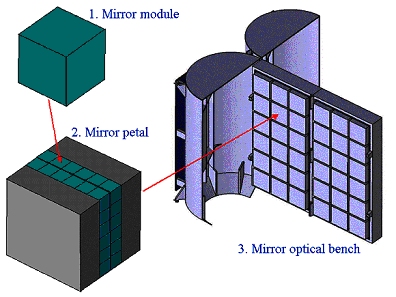The XEUS mission design
 |
|
Artist's impression of XEUS |
SCI-AT heavily supported the definition of the science requirements. We then took the science requirements and identified a mission architecture. This demonstrated that there was no existing mirror technology for the optics to meet the requirements. Therefore a technology study was initiated in 2002 to take initial ideas into actual working prototypes.
The detection of faint and far-off objects necessitates a very large effective detection area. But the simple upscaling of existing telescope mirrors leads to excessively heavy optics - too heavy for a launch into the favourable L2 observation orbit and far too expensive. A completely revised mission scenario now mitigates previous concerns about the deployable mass: New mirror technology with lightweight optics enables a direct launch to an L2 operational orbit.
The goal of high angular resolution of the telescope combined with the low-mass requirement leads to an outline of a telescope with long focal length, but without the need for supporting structure between the telescope mirror and the detector itself which is located in the focal plane. If the mirror and the focal plane of the telescope are implemented on separate spacecraft, they must be combined in a formation-flying configuration.
 |
|
Formation flight of mirror spacecraft MSC and detector spacecraft DSC |
Based on new optics technology, it has become possible to conceive of a large area, high angular resolution X-ray telescope, which could be deployed into a halo orbit around the Earth-Sun Lagrangian point L2. The more massive Mirror Spacecraft (MSC) flies an inertial orbit, followed by the Detector Spacecraft (DSC), which is tracking the focal position of the telescope. The change between different instruments on the DSC is performed by shifting the DSC location relative to the focal point of the MSC optics. The XEUS telescope is nominally pointing normal to the sun-vector (±15° TBC), i.e. the instantaneously accessible sky area is a great circle of 30° width.
 |
|
Re-pointing NXO. |
With respect to operations, the observatory is operated like a single spacecraft. The MSC performs a standard slew, with the DSC following the focal position of the optics and simultaneously performing a synchronous slew around its centre of mass.
 |
|
Nested mirror modules in the MSC |
The implementation of a long focal length that provides the required high resolution optics additionally benefits from a maximum grazing reflectivity of the mirror and the use of a Wolter 1 conical approximation with good resolution.
